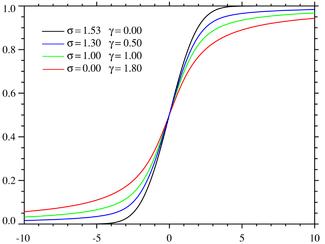Voigt profile
Probability density function Plot of the centered Voigt profile for four cases. Each case has a full width at half-maximum of very nearly 3.6. The black and red profiles are the limiting cases of the Gaussian (γ =0) and the Lorentzian (σ =0) profiles respectively. | |
Cumulative distribution function | |
| Parameters |  |
|---|---|
| Support |  |
![{\frac {\Re [w(z)]}{\sigma {\sqrt {2\pi }}}},~~~z={\frac {x+i\gamma }{\sigma {\sqrt {2}}}}](/2014-wikipedia_en_all_02_2014/I/media/6/1/3/2/6132ac3548467475188c7b93ebf10016.png) | |
| CDF | (complicated - see text) |
| Mean | (not defined) |
| Median |  |
| Mode |  |
| Variance | (not defined) |
| Skewness | (not defined) |
| Ex. kurtosis | (not defined) |
| MGF | (not defined) |
| CF |  |
In spectroscopy, the Voigt profile (named after Woldemar Voigt) is a line profile resulting from the convolution of two broadening mechanisms, one of which alone would produce a Gaussian profile (usually, as a result of the Doppler broadening), and the other would produce a Lorentzian profile. Voigt profiles are common in many branches of spectroscopy and diffraction. Due to the computational expense of the convolution operation, the Voigt profile is often approximated using a pseudo-Voigt profile.
All normalized line profiles can be considered to be probability distributions. The Gaussian profile is equivalent to a Gaussian or normal distribution and a Lorentzian profile is equivalent to a Lorentz or Cauchy distribution. Without loss of generality, we can consider only centered profiles which peak at zero. The Voigt profile is then a convolution of a Lorentz profile and a Gaussian profile:
where x is frequency from line center,  is the centered Gaussian profile:
is the centered Gaussian profile:
and  is the centered Lorentzian profile:
is the centered Lorentzian profile:
The defining integral can be evaluated as:
where Re[w(z) ] is the real part of the Faddeeva function evaluated for
Properties
The Voigt profile is normalized:
since it is the convolution of normalized profiles. The Lorentzian profile has no moments (other than the zeroth) and so the moment-generating function for the Cauchy distribution is not defined. It follows that the Voigt profile will not have a moment-generating function either, but the characteristic function for the Cauchy distribution is well defined, as is the characteristic function for the normal distribution. The characteristic function for the (centered) Voigt profile will then be the product of the two:
Since both the normal and the Cauchy distribution are stable distributions, they are closed under convolution and it follows that the Voigt distribution will also be closed under convolution.
Cumulative distribution function
Using the above definition for z , the CDF can be found as follows:
Substituting the definition of the Faddeeva function (scaled complex error function) yields for the indefinite integral:
Which may be solved to yield:
where  is a hypergeometric function. In order for the function to approach zero as x approaches negative infinity (as the CDF must do), an integration constant of 1/2 must be added. This gives for the CDF:
is a hypergeometric function. In order for the function to approach zero as x approaches negative infinity (as the CDF must do), an integration constant of 1/2 must be added. This gives for the CDF:
The width of the Voigt profile
The full width at half maximum (FWHM) of the Voigt profile can be found from the widths of the associated Gaussian and Lorentzian widths. The FWHM of the Gaussian profile is
The FWHM of the Lorentzian profile is just  . Define
φ =
. Define
φ =  . Then the FWHM of the Voigt profile (
. Then the FWHM of the Voigt profile ( ) can be estimated as:
) can be estimated as:
where  = 2.0056 and
= 2.0056 and  = 1.0593. This estimate will have a standard deviation of error of about 2.4 percent for values of φ between 0 and 10. Note that the above equation will be exactly correct in the limit of φ = 0 and φ = ∞, that is for pure Gaussian and Lorentzian profiles.
= 1.0593. This estimate will have a standard deviation of error of about 2.4 percent for values of φ between 0 and 10. Note that the above equation will be exactly correct in the limit of φ = 0 and φ = ∞, that is for pure Gaussian and Lorentzian profiles.
A better approximation with an accuracy of 0.02% is given by[1]
This approximation will be exactly correct for a pure Gaussian, but will have an error of about 0.0325 percent for a pure Lorentzian profile.
The uncentered Voigt profile
If the Gaussian profile is centered at  and the Lorentzian profile is centered at
and the Lorentzian profile is centered at  , the convolution will be centered at
, the convolution will be centered at  and the characteristic function will then be:
and the characteristic function will then be:
The mode and median will then both be located at  .
.
Voigt functions
The Voigt functions[2] U, V, and H (sometimes called the line broadening function) are defined by
where
erfc is the complementary error function, and w(z) is the Faddeeva function.
Relation to Voigt Profile
 ,
,
with
and
References
- ↑ Olivero, J.J.; R.L. Longbothum (February 1977). "Empirical fits to the Voigt line width: A brief review". Journal of Quantitative Spectroscopy and Radiative Transfer 17 (2): 233–236. Bibcode:1977JQSRT..17..233O. doi:10.1016/0022-4073(77)90161-3. ISSN 0022-4073. Retrieved 2009-04-01.
- ↑ Temme, N. M. (2010), "Voigt function", in Olver, Frank W. J.; Lozier, Daniel M.; Boisvert, Ronald F.; Clark, Charles W., NIST Handbook of Mathematical Functions, Cambridge University Press, ISBN 978-0521192255, MR 2723248
External links
- http://apps.jcns.fz-juelich.de/libcerf, numeric C library for complex error functions, provides a function voigt (x, sigma, gamma) with approximately 13-14 digits precision.



![V(x;\sigma ,\gamma )={\frac {{\textrm {Re}}[w(z)]}{\sigma {\sqrt {2\pi }}}}](/2014-wikipedia_en_all_02_2014/I/media/9/9/7/1/997149f06357a327773ab3a33f41010e.png)




![{\frac {1}{{\sqrt {\pi }}}}\int w(z)\,dz={\frac {1}{{\sqrt {\pi }}}}\int e^{{-z^{2}}}\left[1-{\mathrm {erf}}(-iz)\right]\,dz](/2014-wikipedia_en_all_02_2014/I/media/0/3/e/4/03e4fb1b51ab8bf807ee71619a055a41.png)

![F(x;\mu ,\sigma )={\mathrm {Re}}\left[{\frac {1}{2}}+{\frac {{\mathrm {erf}}(z)}{2}}+{\frac {iz^{2}}{\pi }}\,_{2}F_{2}\left(1,1;{\frac {3}{2}},2;-z^{2}\right)\right]](/2014-wikipedia_en_all_02_2014/I/media/a/4/2/0/a42069b18ef999be510d806eaddf5b14.png)








